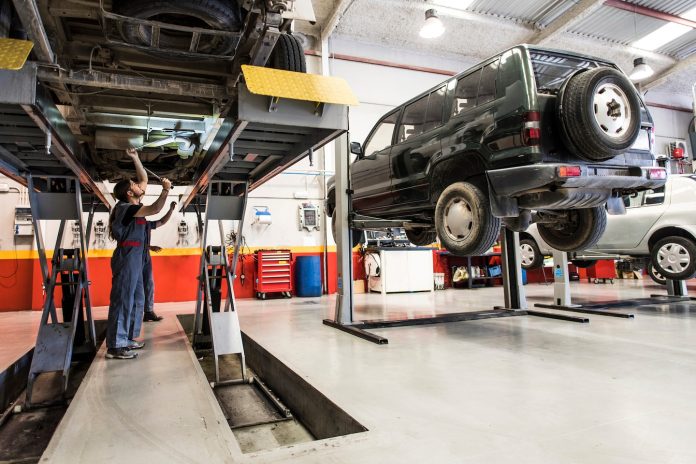Sign in
Whether it’s a door dinged by a runaway grocery cart, a bumper crumpled in a fender bender or a full-on collision that left your vehicle a twisted, ugly mess, at some point you may need an auto body repair shop.
The good news is that most collision centers now offer one-stop shopping and should be able to fully repair your car from start to finish, including mechanical and body repairs. The hurdle for consumers is cutting through the hype to find a reputable business that can restore your car to its original condition.
“Remember: You are an amateur, and you need a professional. Proper repair and the integrity of the car is most important — not the price of the repair,” says Brian Haggerty, owner of Cross Island Collision in New York. Of course, as drivers, we hope nothing bad ever happens, but should the need arise, here are tips on how to find a good auto body shop.
Your best resource may be a neighbor or friend. Check networks such as Nextdoor and look at online reviews. If you find negative comments, see how they were resolved, says Julie Bausch, managing editor of Car Talk, which offers unbiased reviews and advice. Note how long the shop has been in the community. Does it have a good reputation? Word of mouth is still the best marketing for small-business owners. The best ones want you to have such a good experience that you’ll tell your friends and neighbors, says Haggerty, who has more than 40 years of experience in the collision repair industry. Your insurance company also may be a good reference — even if you haven’t been in an accident and just want a cosmetic repair — because it conducts background checks on shops and verifies manufacturer and industry certifications.
Although the insurance company may have its “direct repair programs” or preferred partners that can expedite the process, you can take your vehicle to the center of your choice, Bausch says. She speaks from experience. The day after Bausch brought home her pre-owned hybrid, a delivery service truck took off the back of her parked car. “Their insurance carrier wanted me to go to a dealership,” she says. “Instead, I found a local, long-standing independent shop with positive reviews that provided a seamless experience, from towing to insurance to repair, and restored the car to brand new.”
Don’t be intimidated, Bausch says. You are entitled to as much information as you want before agreeing to use a body shop. Some good questions to ask include:
Look for a shop that offers a lifetime guarantee on workmanship, Haggerty says. The bottom line: Make sure the shop is equipped to fix your car.
This may sound simple, but you need to know your car’s make, model and year when contacting a repair center. “You want a place that is certified to work on that specific vehicle, with the right equipment, training and parts,” says Ryan Marrinan, a senior application engineer at 3M and a collision repair specialist. “For example, not all shops can fix a Porsche, because Porsche will only sell parts to a Porsche-certified shop. So, if you have a Nissan, find a couple of Nissan-certified shops.” Also, ask whether the shop uses OEM (original equipment manufacturer) or aftermarket (equipment made by another company that may be used as a replacement) parts. You want the former.
Any estimates should be free and in writing. The estimator should explain the repairs and what the repair center will do. Marrinan says the best shops will clean the car before writing an estimate, to make sure there isn’t damage hiding under dirt and grime. They should also examine the car indoors or in the shade and away from direct sunlight to avoid missing areas that need repairs. The estimator will take detailed notes, as well as pictures of the entire vehicle. All the data and images should be uploaded into a file sent to both the insurance company and you.
When you walk into the reception area, look for OEM manufacturer-specific certifications. Because they are costly and time-consuming to receive, certificates typically will be displayed prominently, Marrinan says. Look at the shop and its environment. If it’s a messy junkyard outside, it’s probably a mess inside, too. Although many repair shops don’t like the public peeking under the hood, feel free to ask for a tour of the work areas. “I’ve given many tours of my shop and am happy to do so,” Haggerty says. “I’m proud of what I’ve accomplished.”
No matter the repair, even if it’s as simple as a dented fender, the paint process alone takes about three days. This includes sanding, priming, painting, sealing and drying time between each step. “Ninety percent of today’s cars are of unibody construction, so you can’t just touch up a spot or remove a single piece,” Haggerty says. “A bumper cover may wrap all the way around to the rear doors.” Then factor in shipping time for parts. Plus, vehicles are loaded with safety features. That means replacing a windshield isn’t just a matter of popping in a new piece of glass. There may be cameras, rain sensors and monitors that need to be recalibrated. The same may be true for repairing or replacing a front or rear bumper. If all goes as planned, an average repair takes 10 working days, Haggerty says.
Denver-based writer Laura Daily specializes in consumer advocacy and travel strategies. Find her at dailywriter.net.






